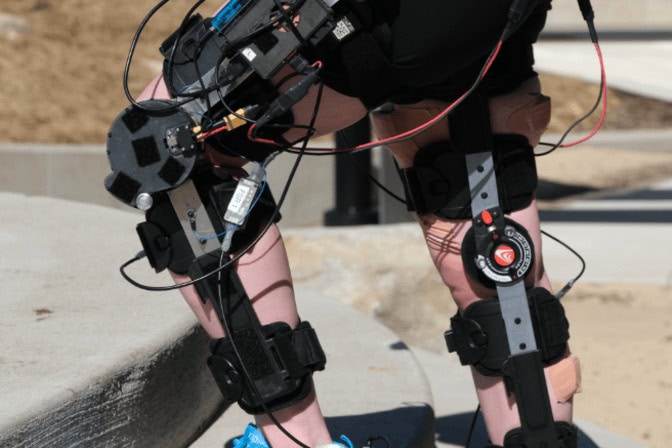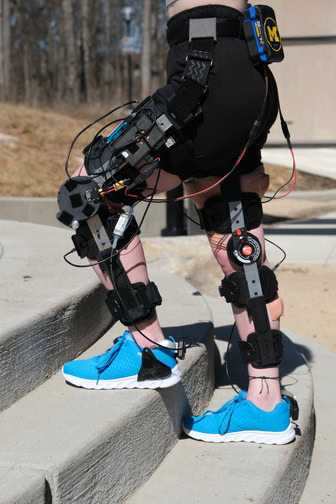
Versatile knee exo for safer lifting
Helping out the quad muscles kept study participants lifting safely despite fatigue, with an algorithm that smoothly shifts between lifting and carrying tasks.

Helping out the quad muscles kept study participants lifting safely despite fatigue, with an algorithm that smoothly shifts between lifting and carrying tasks.
Experts
Postdoctoral Research Fellow in Robotics
A set of knee exoskeletons, built with commercially available knee braces and drone motors at the University of Michigan, has been shown to help counteract fatigue in lifting and carrying tasks. They helped users maintain better lifting posture even when tired, a key factor in defending against on-the-job injuries, the researchers say.
“Rather than directly bracing the back and giving up on proper lifting form, we strengthen the legs to maintain it,” said Robert Gregg, U-M associate professor of robotics and corresponding author of the study in Science Robotics. “This differs from what’s more commonly done in industry.”
Already workers who lift regularly, such as in construction and manufacturing, may use back braces. Back exoskeletons, which use springs or motors to help with lifting, are an emerging technology. But devices supporting the back assume unsafe lifting, or stooping, and back exoskeletons tend to be cumbersome devices that must be deactivated to allow motions that aren’t part of the lifting task, Gregg said.
A study participant wearing a pair of knee exoskeletons lifts a kettlebell and carries it up and down a ramp. Next to her, a graph shows the aid that the exoskeletons provide – a big pulse from both exoskeletons on lift, alternating pulses from the right and left exos going up the ramp, small pulses in the flat along the top, slightly larger pulses going down the ramp, and a large pulse as she sets the kettlebell back on the ground. She repeats the sequence going back across the ramp.
A graphic shows quadriceps effort reduction with the exoskeletons: 22% for lifting and lowering, 24% for stairs ascent, 11% for stairs descent, 17% for ramp ascent, 10% for ramp descent, and 3% for level walking.
A graphic shows how well the exoskeletons help users overcome fatigue. Without an exoskeleton, a fatigued lifter stooped over by an extra 10.1 degrees. With the exos, that extra lean was reduced to 6.1 degrees. Without the exos, fatigued participants were 44% slower at completing tasks, but with the exos, they were only 1% slower.
Participant feedback ratings: Most gave the exoskeletons a 4 or 5 out of 5, indicating high levels of satisfaction, for most tasks. More difficult tasks, like lifting, lowering, and ascending, received all 4s and 5s. Level walking received mostly 3s. No one rated the exoskeletons at 2 or 1, indicating dissatisfaction, for any task.
The Michigan team says their knee exoskeletons are the first to support the quadriceps muscles instead, which provide the bulk of the force in safe squat lifting, as a less intrusive way to help protect workers from back injuries. Study participants tested them out with lifting and carrying tasks using a 20 lb kettlebell.
The tasks included lifting the weight off the ground and setting it down again, and lifting and carrying the weight on flat ground, up and down an incline, and up and down stairs. The study found that, after becoming fatigued, the participants kept better posture with the help of the exoskeleton, and they also lifted faster—just 1% slower than their pre-fatigued paces, versus 44% slower without the aid of the exoskeletons.
“This is especially important when a worker has to keep up with a conveyor belt. Usually, when a worker is fatigued, they’ll keep up with that rate, but with a compromised posture. They’ll bend their back more, and that’s when injuries are most likely,” said Nikhil Divekar, a postdoctoral research fellow in robotics at U-M and first author of the study.
The participants felt the benefit, too—they mainly said they were quite or very satisfied, with the exception of walking on level ground, for which they were more or less satisfied. This tracks with the small amount of assistance required by the quadriceps during this relatively easy task; Gregg described it as just enough support to counteract the weight of the exoskeleton.

One of the keys to making the exoskeleton so wearable is the motors and the way that they are geared, which enables users to swing their knees freely for a natural gait. The other is the software, which predicts what kind of assistance the user needs by measuring the angle of the knee joint, the orientations of the thigh and lower leg, and the force picked up by a sensor in the user’s shoe.
With these three measurements from both legs, it’s possible to work out what motion the user is trying to do, and how much assistance to give. These measurements were taken 150 times per second, enabling the exos to move seamlessly between activities.
This approach is in contrast to many exo controllers, which follow predefined patterns for a limited set of tasks. Switching tasks can be a problem for these controllers, and they may need a full second to figure out what the user is trying to do, Gregg said.
“If your exo is trying to walk upstairs, and you’re trying to walk downstairs, that could be a problem, right?” he said.
The new controller also pairs a physics model with machine learning, which prevents the exoskeleton from making unexpected moves if the user begins behaving differently than any activity included in the controller’s training data.
The lab prototypes cost about $4,000 per pair, so Gregg anticipates that if the exoskeletons were produced at scale, they might cost about $2,000 per pair.
The 10 study participants, five women and five men, did all the tasks on two different days, one day fresh and the other fatigued. To induce fatigue, each participant performed a series of squat lifts with the kettlebell until they couldn’t continue without a long break between repetitions. All participants had experience with proper squat lifting techniques.
The study was funded by the National Institutes of Health.
The team has applied for patent protection with the assistance of U-M Innovation Partnerships and is seeking partners to bring the technology to market.
Gray Thomas, Avani Yerva and Hannah Frame contributed to the study.
Gregg is also an associate professor of electrical and computer engineering and mechanical engineering.